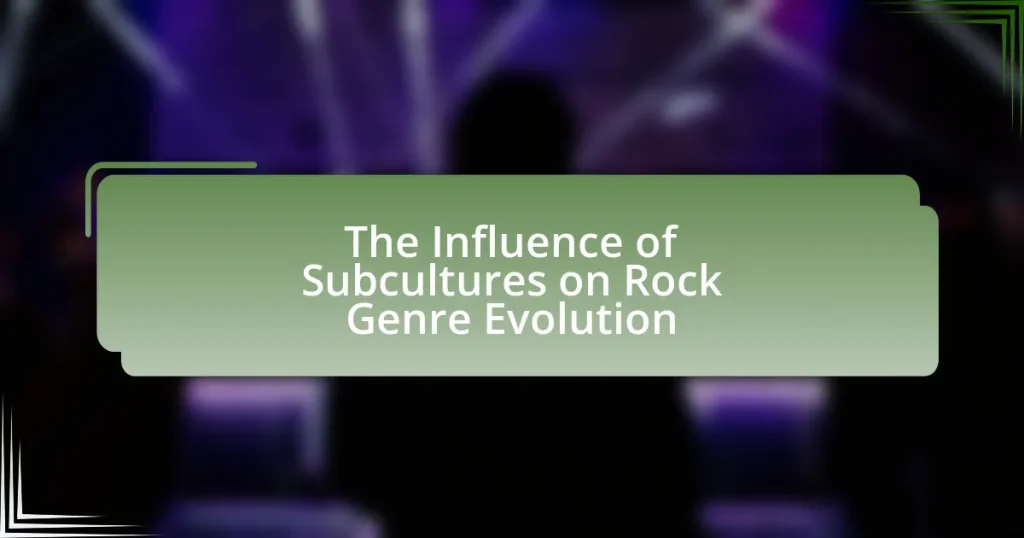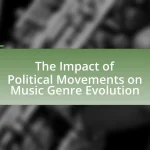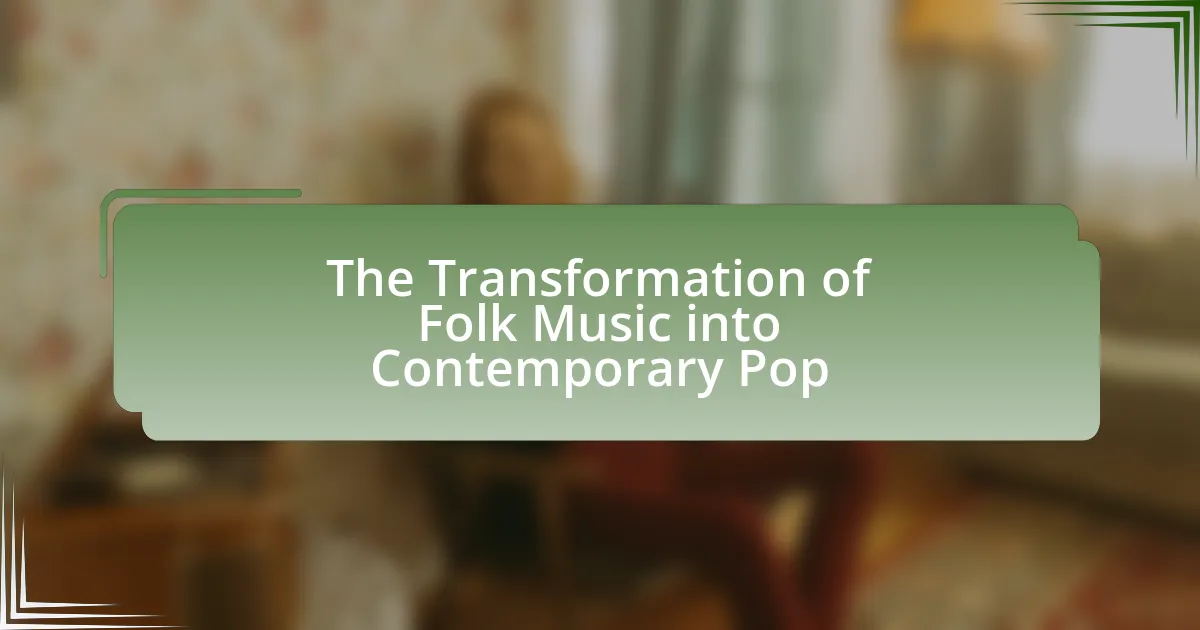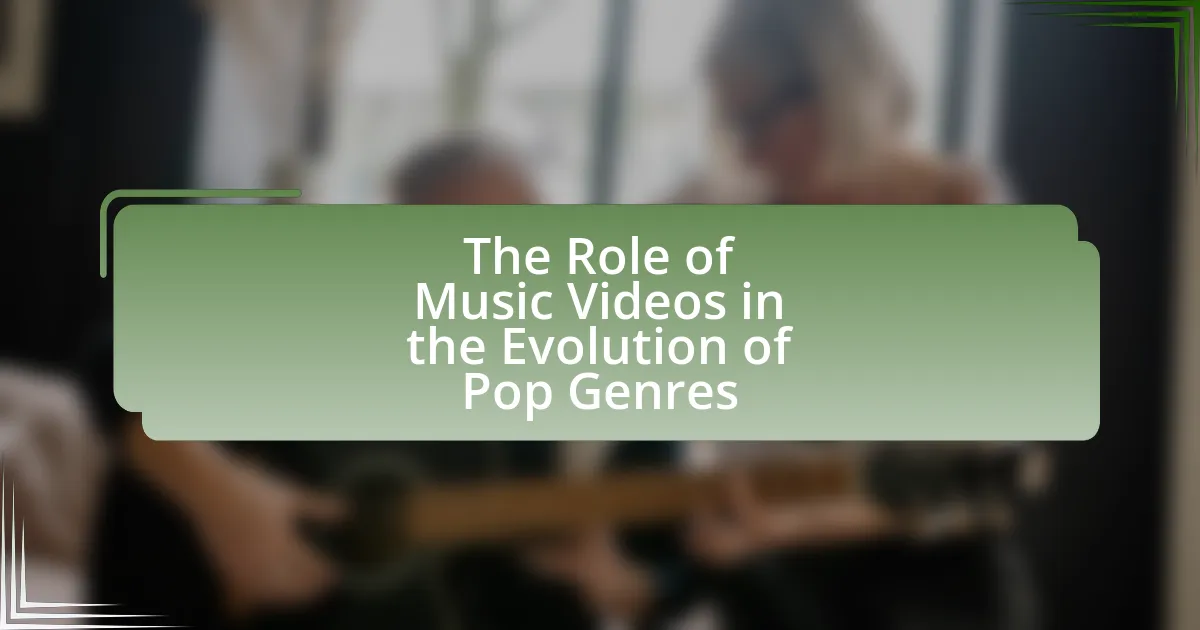The article examines the significant influence of subcultures on the evolution of rock music genres. It highlights how movements such as punk, grunge, and the hippie culture have introduced distinct styles, themes, and ideologies that have reshaped musical expression and community identity. Key discussions include the reciprocal relationship between subcultures and rock music, the impact of socio-political contexts on lyrical content, and the ongoing relevance of subcultures in modern rock. Additionally, the article explores how emerging artists can leverage these subcultures to enhance their music careers and the trends likely to arise from their intersection with rock music.
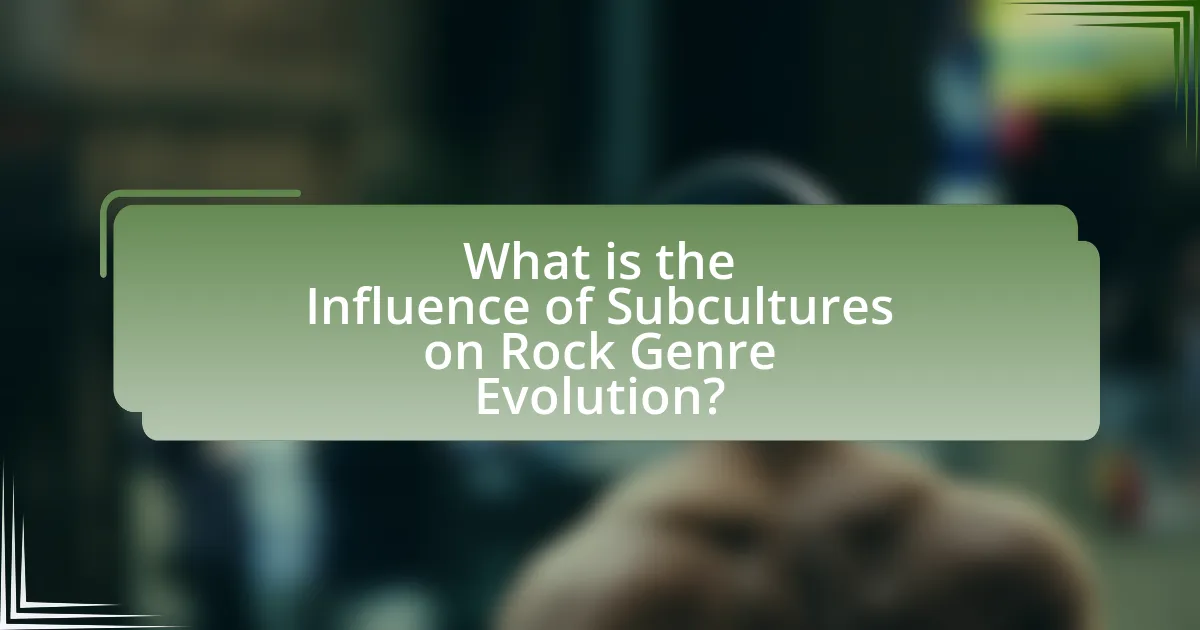
What is the Influence of Subcultures on Rock Genre Evolution?
Subcultures significantly influence the evolution of rock genres by introducing distinct styles, ideologies, and aesthetics that reshape musical expression. For instance, the punk subculture of the 1970s emphasized anti-establishment themes and raw sound, leading to the emergence of punk rock, which rejected the polished production of mainstream rock. Similarly, the grunge movement in the 1990s, rooted in the Seattle music scene, combined elements of punk and heavy metal, resulting in a genre characterized by its angst-driven lyrics and distorted guitars. These subcultures not only fostered new musical styles but also created communities that supported and promoted these genres, demonstrating the reciprocal relationship between subcultures and rock music’s evolution.
How do subcultures shape the development of rock music?
Subcultures significantly shape the development of rock music by influencing its themes, styles, and cultural narratives. For instance, the punk subculture of the 1970s introduced a raw, rebellious sound and anti-establishment lyrics, which were embodied in bands like The Sex Pistols and The Clash. This shift not only altered the musical landscape but also inspired subsequent genres such as grunge and alternative rock, which drew from punk’s ethos of authenticity and resistance. Additionally, the hip-hop subculture has impacted rock music through collaborations and genre-blending, as seen in the works of artists like Kid Rock and Linkin Park, who incorporate rap elements into their rock compositions. These interactions illustrate how subcultures serve as catalysts for innovation and evolution within the rock genre, driving it to reflect diverse social issues and cultural identities.
What are the key subcultures that have impacted rock music?
The key subcultures that have impacted rock music include the Beat Generation, the Hippie movement, Punk, and Grunge. The Beat Generation in the 1950s introduced themes of rebellion and nonconformity, influencing early rock artists like Bob Dylan. The Hippie movement of the 1960s brought psychedelic rock, with bands like The Grateful Dead and Jefferson Airplane embodying countercultural ideals. Punk emerged in the 1970s as a reaction against mainstream music, characterized by bands like The Ramones and Sex Pistols, promoting DIY ethics and social critique. Grunge, which developed in the late 1980s and early 1990s, was shaped by the Seattle music scene and bands like Nirvana and Pearl Jam, reflecting themes of disillusionment and angst. Each of these subcultures contributed distinct musical styles and cultural narratives that have shaped the evolution of rock music.
How do subcultures influence the themes and lyrics in rock music?
Subcultures significantly influence the themes and lyrics in rock music by providing distinct cultural contexts and social commentary that shape the genre’s evolution. For instance, the punk subculture of the 1970s introduced themes of rebellion, anti-establishment sentiments, and social critique, which are evident in the lyrics of bands like The Sex Pistols and The Clash. Similarly, the grunge movement of the 1990s, rooted in the disillusionment of Generation X, brought themes of alienation and introspection, as showcased in the lyrics of Nirvana and Pearl Jam. These subcultures not only inspire lyrical content but also affect the musical style and aesthetic of rock, reflecting the values and struggles of their respective communities.
Why is understanding subcultures important for rock genre evolution?
Understanding subcultures is crucial for rock genre evolution because they serve as the breeding ground for new musical styles and ideas. Subcultures often reflect the social, political, and cultural contexts of their time, influencing the themes and sounds of rock music. For instance, the punk subculture of the 1970s introduced raw, aggressive sounds and anti-establishment lyrics, which significantly shaped the direction of rock music. Additionally, the emergence of grunge in the 1990s, rooted in the disillusionment of Generation X, led to a shift in rock aesthetics and lyrical content. These examples illustrate how subcultures not only inspire innovation within the genre but also help to redefine its boundaries, making the understanding of these cultural movements essential for grasping the evolution of rock music.
What role do subcultures play in the innovation of rock music styles?
Subcultures play a crucial role in the innovation of rock music styles by serving as incubators for new ideas, aesthetics, and sounds. These groups, such as punk, goth, and grunge, often challenge mainstream norms and introduce unique elements that reshape the genre. For instance, the punk subculture of the 1970s emphasized raw energy and DIY ethics, leading to the emergence of fast-paced, stripped-down music that influenced countless bands and styles. Additionally, the grunge movement of the early 1990s, rooted in the Seattle music scene, blended elements of punk and heavy metal, resulting in a sound that defined a generation and expanded rock’s boundaries. This dynamic interaction between subcultures and rock music illustrates how grassroots movements can drive artistic evolution and diversify the genre.
How do subcultures affect the audience and fanbase of rock music?
Subcultures significantly shape the audience and fanbase of rock music by creating distinct identities and communities that influence musical preferences and social behaviors. For instance, the punk subculture in the 1970s fostered a DIY ethos and anti-establishment attitudes, attracting fans who resonated with its rebellious spirit, which in turn led to the emergence of bands like The Sex Pistols and The Clash. This connection between subculture and music not only expanded the fanbase but also encouraged the development of new rock genres, such as punk rock and alternative rock, which catered to the values and aesthetics of these subcultures. Additionally, subcultures often organize events, such as festivals and concerts, that further solidify community ties and enhance the collective experience of rock music, thereby reinforcing loyalty among fans and expanding the genre’s reach.
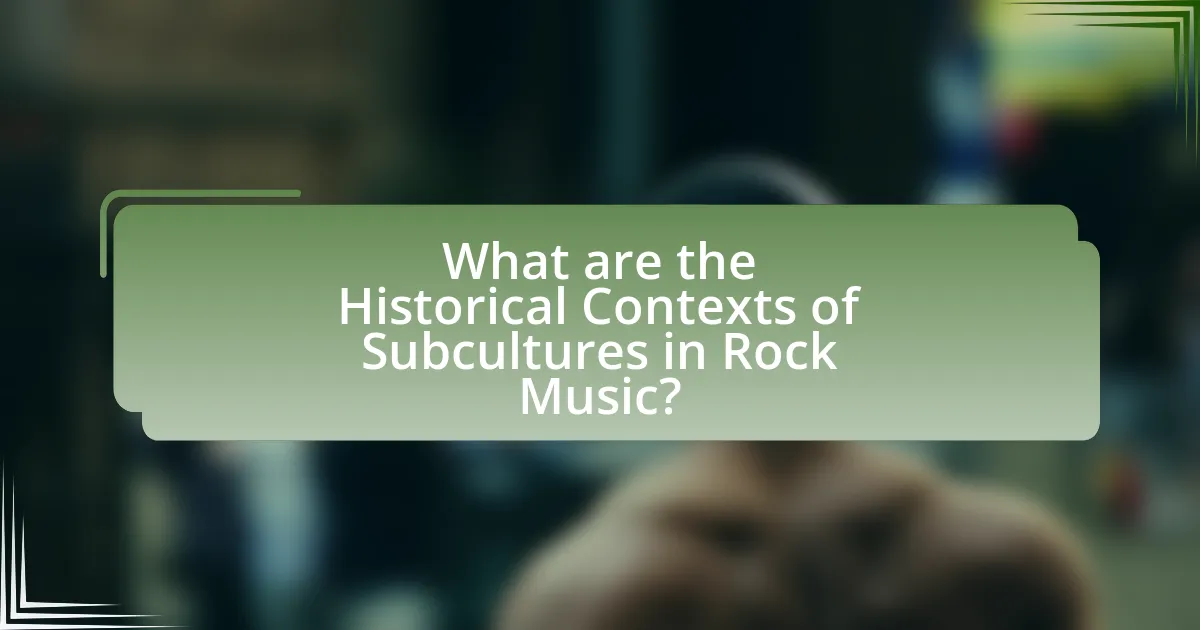
What are the Historical Contexts of Subcultures in Rock Music?
The historical contexts of subcultures in rock music are rooted in the social, political, and cultural movements of the 20th century. Subcultures such as the Beat Generation in the 1950s, the counterculture of the 1960s, and punk in the 1970s emerged as responses to mainstream societal norms, influencing rock music’s themes and styles. For instance, the Beat Generation’s emphasis on nonconformity and artistic expression laid the groundwork for the rebellious spirit of rock, while the 1960s counterculture, marked by anti-war protests and civil rights movements, inspired bands like The Beatles and The Doors to incorporate social commentary into their music. Punk rock, characterized by its DIY ethos and rejection of commercialism, arose in the 1970s as a reaction to both the excesses of mainstream rock and broader societal issues, exemplified by bands like The Ramones and Sex Pistols. These subcultures not only shaped the sound of rock music but also its cultural significance, reflecting and challenging the values of their respective eras.
How did the emergence of subcultures coincide with rock music’s evolution?
The emergence of subcultures coincided with rock music’s evolution by providing distinct identities and social contexts that shaped the genre’s development. For instance, the Beat Generation in the 1950s influenced early rock through its emphasis on rebellion and nonconformity, while the counterculture movement of the 1960s, exemplified by the hippie subculture, popularized psychedelic rock and themes of peace and love. Additionally, punk rock emerged in the 1970s as a reaction to both mainstream culture and the excesses of rock music, reflecting the DIY ethos of punk subcultures. These subcultures not only inspired musical styles but also influenced fashion, language, and social attitudes, demonstrating a reciprocal relationship between rock music and the evolving cultural landscape.
What historical events influenced the rise of specific subcultures in rock?
The rise of specific subcultures in rock was significantly influenced by historical events such as the civil rights movement, the Vietnam War, and the counterculture of the 1960s. The civil rights movement, which sought to end racial segregation and discrimination, inspired artists like Jimi Hendrix and Sly and the Family Stone to incorporate themes of social justice into their music, fostering the emergence of the funk and psychedelic rock subcultures. The Vietnam War, marked by widespread protests and anti-establishment sentiments, led to the rise of protest music, with bands like Creedence Clearwater Revival and Buffalo Springfield voicing opposition to the war, thus shaping the folk rock and protest rock subcultures. Additionally, the counterculture movement of the 1960s, characterized by a rejection of mainstream values and an embrace of alternative lifestyles, gave rise to the hippie subculture, which was closely associated with psychedelic rock, as seen in the works of bands like The Grateful Dead and Jefferson Airplane. These historical events collectively shaped the evolution of rock subcultures by influencing the themes, styles, and ideologies expressed in the music.
How did the socio-political climate shape rock subcultures?
The socio-political climate significantly shaped rock subcultures by influencing the themes, styles, and ideologies expressed in the music. For instance, during the 1960s, the civil rights movement and anti-Vietnam War protests inspired rock musicians to address social justice and political dissent in their lyrics, leading to the emergence of subcultures like counterculture and punk. Bands such as The Beatles and The Rolling Stones reflected the era’s upheaval, while the punk movement in the 1970s directly responded to economic instability and disillusionment with mainstream society, promoting a DIY ethos and rebellion against authority. This connection between socio-political events and rock subcultures illustrates how external factors can drive artistic expression and community identity within the genre.
What are some notable examples of subcultures influencing rock genres?
Notable examples of subcultures influencing rock genres include the punk movement, which emerged in the 1970s, characterized by its DIY ethic and anti-establishment attitude, leading to the development of punk rock. The goth subculture, originating in the late 1970s, influenced the creation of gothic rock, marked by dark aesthetics and themes. Additionally, the grunge movement of the early 1990s, rooted in the Seattle music scene, shaped alternative rock with its themes of disillusionment and angst. Each of these subcultures not only contributed distinct musical styles but also shaped the cultural narratives surrounding rock music during their respective eras.
How did punk rock emerge from the punk subculture?
Punk rock emerged from the punk subculture as a musical expression of the anti-establishment attitudes and DIY ethos prevalent within that community. The punk subculture, which developed in the mid-1970s, was characterized by its rejection of mainstream culture, embracing a raw, aggressive sound and a distinctive fashion style. Bands like the Ramones, Sex Pistols, and The Clash drew inspiration from the subculture’s ideals, creating music that reflected its rebellious spirit and social commentary. This connection is evident in the lyrics and sound of early punk rock, which often addressed themes of disillusionment and resistance against societal norms, solidifying punk rock as a direct product of the punk subculture’s values and aesthetics.
What impact did the hippie movement have on psychedelic rock?
The hippie movement significantly influenced psychedelic rock by promoting themes of peace, love, and expanded consciousness, which became central to the genre’s identity. This cultural shift in the 1960s encouraged musicians to experiment with sound, lyrics, and visual aesthetics, leading to the creation of iconic albums such as The Beatles’ “Sgt. Pepper’s Lonely Hearts Club Band” and Jefferson Airplane’s “Surrealistic Pillow.” The movement’s embrace of mind-altering substances like LSD also directly inspired the music’s surreal and often abstract qualities, as artists sought to replicate and express altered states of consciousness through their work.
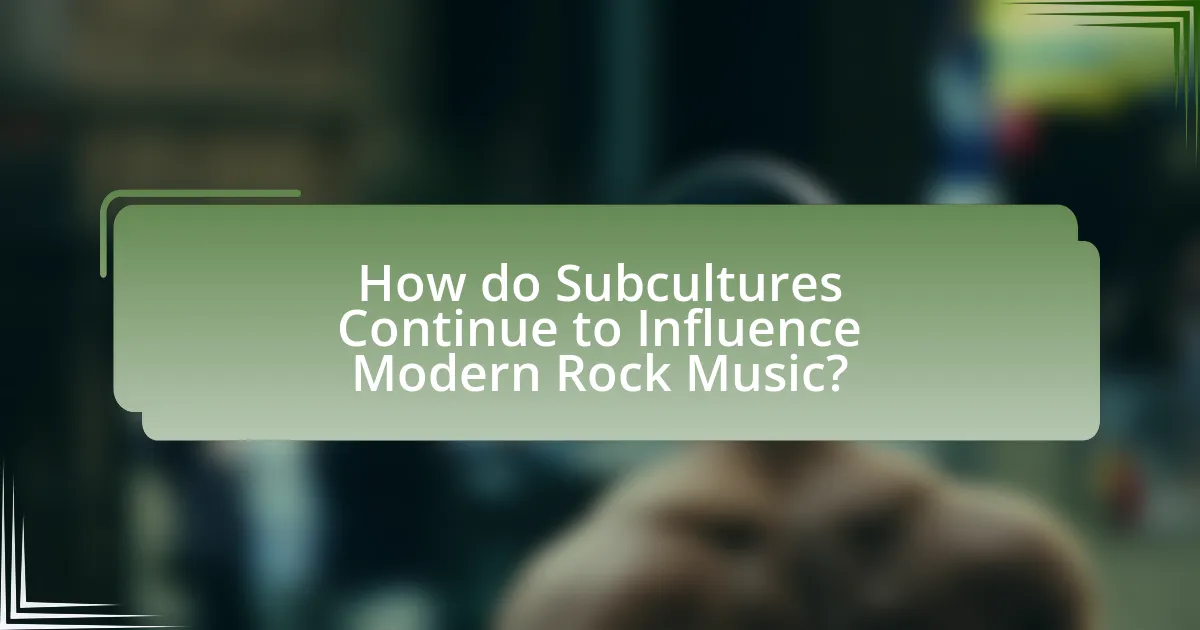
How do Subcultures Continue to Influence Modern Rock Music?
Subcultures continue to influence modern rock music by shaping its themes, aesthetics, and sound. For instance, the punk subculture, which emerged in the 1970s, introduced a raw, rebellious attitude that persists in contemporary rock bands like Green Day and The Offspring, who incorporate punk’s anti-establishment messages into their lyrics. Additionally, the goth subculture has impacted the visual and musical elements of rock, evident in bands like My Chemical Romance, which blend dark themes and theatricality into their performances. Furthermore, the rise of digital platforms has allowed niche subcultures, such as emo and metalcore, to thrive, leading to a diversification of rock music that reflects various cultural identities and experiences. This ongoing interaction between subcultures and rock music demonstrates a dynamic evolution, where new influences continually reshape the genre.
What current subcultures are shaping the rock genre today?
Current subcultures shaping the rock genre today include emo revival, punk rock resurgence, and the influence of digital communities like TikTok. The emo revival has brought back emotional expression and introspective lyrics, with bands like Modern Baseball and The Front Bottoms gaining popularity. The punk rock resurgence is characterized by a return to DIY ethics and political themes, seen in groups like Idles and Amyl and the Sniffers. Additionally, TikTok has enabled new artists to gain traction rapidly, influencing trends and sounds in rock music, as evidenced by the viral success of songs like “Meet Me at Our Spot” by The Anxiety. These subcultures collectively contribute to the evolving landscape of rock music, reflecting contemporary societal issues and youth experiences.
How is the digital age affecting the relationship between subcultures and rock music?
The digital age is transforming the relationship between subcultures and rock music by facilitating greater access to diverse musical influences and enabling subcultures to create and share their own interpretations of rock. This shift is evidenced by the rise of platforms like SoundCloud and Bandcamp, where independent artists from various subcultures can distribute their music without traditional gatekeepers, leading to a fusion of genres and styles that reflect their unique identities. Additionally, social media allows subcultures to connect globally, promoting niche rock genres and fostering communities that celebrate specific musical aesthetics, as seen in the resurgence of interest in punk and metal through online forums and streaming services.
What role do social media platforms play in the evolution of rock subcultures?
Social media platforms significantly influence the evolution of rock subcultures by facilitating communication, collaboration, and the dissemination of music and ideas among fans and artists. These platforms enable niche communities to form, allowing individuals to share their unique interpretations of rock music, which can lead to the emergence of new subgenres. For instance, the rise of platforms like Instagram and TikTok has allowed underground bands to gain visibility and connect with audiences globally, bypassing traditional music industry gatekeepers. This democratization of music distribution is evidenced by the success of artists who have gained popularity through viral social media trends, illustrating how these platforms shape the cultural landscape of rock.
What are the implications of subculture influence on the future of rock music?
Subculture influence will significantly shape the future of rock music by introducing diverse sounds, themes, and aesthetics that reflect the values and identities of various groups. As seen in the past, movements like punk, grunge, and emo emerged from specific subcultures, each bringing unique elements that redefined rock music’s boundaries. For instance, the punk rock movement of the 1970s challenged mainstream norms and emphasized DIY ethics, which led to a surge of independent labels and underground scenes. This trend continues today, as genres like trap metal and hyperpop, which draw from hip-hop and electronic music, are gaining traction within rock circles, indicating a blending of styles that caters to younger audiences. The ongoing evolution of rock music will likely mirror the changing dynamics of subcultures, as artists increasingly draw inspiration from a wider array of influences, ensuring that rock remains relevant and reflective of contemporary societal issues.
How can emerging artists leverage subcultures for their music careers?
Emerging artists can leverage subcultures by aligning their music and branding with the values and aesthetics of specific groups, thereby gaining a dedicated fanbase. For instance, artists who tap into the punk subculture often adopt a DIY ethos and anti-establishment themes, which resonate with fans who value authenticity and rebellion. This alignment can lead to increased visibility through niche events, social media communities, and collaborations with other artists within the subculture. Historical examples include bands like The Clash, who gained prominence by embodying the punk spirit, and more recently, artists like Billie Eilish, who connect with Gen Z through their unique style and relatable themes. By engaging with subcultures, emerging artists can create a strong identity and foster loyalty among fans, ultimately enhancing their music careers.
What trends are likely to emerge from the intersection of subcultures and rock music?
Trends likely to emerge from the intersection of subcultures and rock music include the fusion of diverse musical styles, increased emphasis on social and political themes, and the rise of niche genres. The blending of subcultures such as punk, metal, and hip-hop with rock music has historically led to innovative sounds, as seen in the emergence of genres like rap-rock and nu-metal in the late 1990s. Additionally, subcultures often reflect societal issues, prompting rock artists to address topics like identity, inequality, and activism in their lyrics, similar to the protest songs of the 1960s. Furthermore, the growth of online communities allows for the rapid dissemination of niche genres, enabling smaller subcultures to influence mainstream rock music, as evidenced by the popularity of genres like emo and indie rock in the 2000s.
What practical insights can be drawn from the influence of subcultures on rock genre evolution?
Subcultures significantly shape the evolution of rock genres by introducing distinct styles, themes, and cultural narratives. For instance, the punk subculture in the 1970s emphasized anti-establishment sentiments and raw musical energy, leading to the emergence of punk rock, which rejected the polished sound of mainstream rock. This shift not only diversified the rock genre but also influenced subsequent movements, such as grunge and alternative rock, which incorporated elements of punk’s rebellious ethos. Additionally, the hip-hop subculture has impacted rock through collaborations and genre-blending, as seen in the fusion of rock and rap in the works of artists like Kid Rock and Linkin Park. These examples illustrate how subcultures drive innovation and redefine musical boundaries within rock, demonstrating the genre’s adaptability and responsiveness to cultural shifts.
